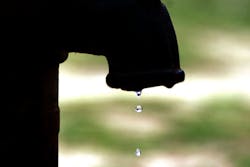San Diego County Water: supply is sufficient to meet demand well past 2017
SAN DIEGO, CA, OCTOBER 3, 2016 -- As the 2016 water year comes to a close, San Diego County Water Authority officials said that the region’s projected water supplies will be sufficient to meet demand in 2017 and beyond, but continued water-use efficiency remains essential to help the region manage those supplies amid an uncertain outlook for rain and snow this winter.
Even if conditions remain dry, San Diego County’s water supplies will meet demands due to drought-resilient water resources such as the Claude "Bud" Lewis Carlsbad Desalination Plant, which produces approximately 50 million gallons of potable water per day, and conservation-and-transfer contracts and agreements for high-priority water from the Colorado River. Those resources and others allowed the Water Authority to pass the state’s stringent water reliability stress test, which requires water agencies to demonstrate they have adequate water supplies to meet demands even if they experience three additional dry years.
The Water Authority also announced that regional water savings stayed strong during the summer. From June through August, urban potable water use in San Diego County was 18 percent below the same period in 2013 even though state-mandated emergency water-use reductions were lifted in June and average daily maximum temperatures were 2 degrees above normal. In addition, conditions were cooler at Lindbergh Field during the June-August 2013 period, when average daily maximum temperatures were 0.4 degrees below average.
"The San Diego region has a track record of smart investments in supply reliability and water-use efficiency that have proven their worth during five years of drought," said Mark Muir, whose term as Water Authority Board chair begins Oct. 1. "In addition, the commitment our region’s residents and businesses continue to show for saving water is remarkable. The goal going forward is to maintain the momentum and to Live WaterSmart by eliminating leaks, adopting WaterSmart landscapes and continuing to embrace other water-efficient practices that are becoming the norm."
Muir spoke Friday at a news briefing at the Water Authority’s Kearny Mesa headquarters to discuss weather and water supply conditions at the start of the 2017 water year, which begins Oct. 1. Water managers commonly use water years to track rain and snow that collects for use the following spring and summer. Other speakers included Postdoctoral Fellow Amanda Sheffield from the Scripps Institution of Oceanography at UC San Diego, and Dana Friehauf, water resources manager for the Water Authority.
Sheffield said the potential for a La Niña weather pattern to form this fall in the Pacific Ocean is weakening. That makes forecasting the snowpack and runoff levels in major watersheds such as the Sierra Nevada and Rocky Mountains less predictable. While La Niña conditions remain in question, the National Oceanic and Atmospheric Administration has predicted warmer-than-average temperatures across the West through December. Warmer temperatures typically put upward pressure on water use.
Friehauf said that while statewide water supply and weather conditions are uncertain, San Diego County is benefiting from its development of alternative water supplies and major infrastructure since the early 1990s. This long-term strategy, put in place after five straight years of drought conditions led the Metropolitan Water District of Southern California to cut water deliveries to the region by 31 percent, was specifically designed to help the region better withstand droughts or other water supply challenges.
"These investments have greatly enhanced the reliability of our region’s water supplies, both now and for decades to come," Friehauf said. "However, we are in a long and hot stretch statewide, and history reminds us that dry spells can last for many years. That means we must always be efficient with our water resources."
Friehauf said the region has a very strong track record for reducing water use through long-term efficiency efforts and also through short-term conservation measures in response to drought, reducing per capita water use nearly 40 percent between 1990 and 2015. Extraordinary water conservation actions to comply with emergency state mandates have further decreased per capita potable water use, lowering it to 119 gallons per day in fiscal year 2016. That’s down nearly 50 percent from 1990, when the region used 235 gallons per day.
Since May 2015, the Water Authority has stored 100,000 acre-feet of conserved water at the recently enlarged San Vicente Reservoir as part of its Emergency and Carryover Storage Project to set aside supplies in case emergencies arise or dry weather continues. An acre-foot is approximately 325,900 gallons, enough to serve two typical families of four for a year.
The Water Authority is promoting ongoing water-use efficiency with its Live WaterSmart campaign, which encourages residents and businesses to avoid water waste and to take advantage of regional water-saving resources, including free water-efficient landscaping classes and videos for homeowners, and free water-use checkups. To learn more about those resources and others, visit WaterSmartSD.org.
While no mandatory water-use reduction targets are expected through the end of this calendar year, the State Water Resources Control Board is scheduled to reconsider its emergency drought response regulations in January 2017. The State Board has said it will evaluate statewide rain and snow levels and conservation efforts in determining whether any modifications are needed to the regulation.
